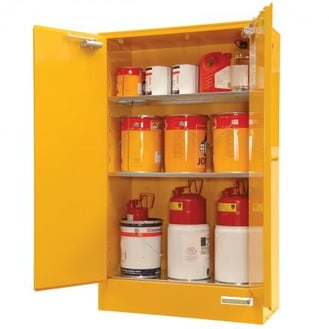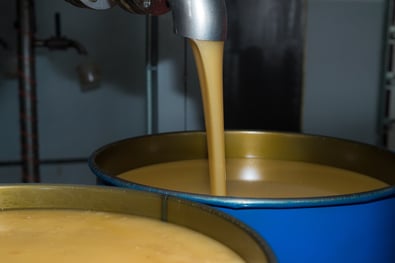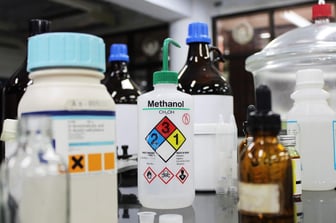When we’re helping a customer set up a safe chemical storage system, a common question we hear is, ‘Is it OK to decant chemicals from my flammable liquids cabinet?’ And, just like the response to many questions about workplace chemical compliance, our answer is, ‘It depends on your risk assessment.’ So, if you’re wondering if you can use your indoor flammable cabinet as a chemical decanting station, we’ve put together a list of 6 critical considerations that you can include in your next risk assessment.
Consideration #1. Australian Safety Standards
Your indoor flammable liquids cabinet is only an acceptable hazard control measure if it’s constructed, installed, loaded and maintained in accordance with the Australian Standard AS1940:2017 – The storage and handling of flammable and combustible liquids.
 Your flammable cabinet must meet all requirements of AS 1940:2017 to maintain compliance.
Your flammable cabinet must meet all requirements of AS 1940:2017 to maintain compliance.
Your workplace risk assessment should consider each of the following requirements of the standard:
- Persons shall be prevented from entering the cabinet. Would decanting require a worker to enter the cabinet for any reason?
- Drums shall not be stacked more than two high if they are greater than 60 L capacity. Would decanting change drum stacking patterns?
- Only one drum of more than 60 L capacity should be kept in a horizontal (decanting) position at any time. Would decanting require more than one drum to be stored horizontally?
- Only closed packages, or those fitted with a tap, should be stored in the cabinet. Would decanting require the opening of the chemical containers while inside the cabinet? And if using fitted taps, are they creating a full seal?
IMPORTANT: Any deviation from the Australian Standard may negate the effectiveness of the cabinet as a chemical hazard control measure.
Consideration #2. Fire and Explosion Hazards
Next in your risk assessment, you should consider if the risk of fire or explosions is increased if you choose to decant straight from your flammable cabinet.
Remember, every time the cabinet doors are open, chemicals are vulnerable to ignition sources that may be in the area.
Ignition sources that are within a 3 metre radius of the cabinet can cause the flammables to ignite and cause a workplace fire. There are many types of ignition sources that can be present in the workplace, including static electricity, other electrical discharge, flames, sparks and hot work.
Therefore, indoor flammable liquids cabinets are specifically designed to fully contain the liquid chemicals — as well as their hazardous vapours.
Compliant cabinets also provide a 10-minute fire protection barrier which aids emergency evacuations and the use of firefighting equipment.
Flammable cabinets achieve these hazard control measures due to features including:
- Construction materials and componentry that can withstand more than 850°C.
- Tight-fitting doors that close automatically.
- Having mechanisms in place to release doors (that are equipped with a device to hold them open) — if the temperature rises above a nominal 80°C.
Decanting flammable liquids from the cabinet may interfere with the functionality of the self-closing doors — compromising your flammable cabinet’s effectiveness as a fire/heat barrier for the stored chemicals.
Therefore, your risk assessment will need to consider how often decanting takes place —and how long the cabinet doors will remain open. The safety of your compliant flammable cabinet may be negated if decanting is a regular practice at your workplace.
 Your risk assessment should consider how much the cabinet doors are kept open, as this affects the safety of the cabinet
Your risk assessment should consider how much the cabinet doors are kept open, as this affects the safety of the cabinet
Consideration #3. Vapours and Fumes
All workplaces have a legal responsibility to ensure that all chemical vapours and fumes in the breathing zones of workers are within workplace exposure standards.
The Workplace Exposure Standards For Airborne Contaminants identifies 700+ hazardous substances and lists the maximum levels of airborne exposure for each. This document clearly states how much of a particular chemical can be present in the air without causing harm to workers.
So, with this in mind, your risk assessment should consider if decanting from your flammable cabinet will increase the chemical exposure hazards at your worksite.
Risks that you should consider include the following:
- Health and exposure hazards of the chemicals (eg irritant, toxic, corrosive, carcinogenic).
- Maximum storage capacity of the flammable liquids cabinet.
- Aggregate quantity of the store.
- Proximity to first aid equipment, safety showers and eyewash units.
- Frequency of decanting.
- Quantities of chemicals being decanted.
REMEMBER: As you’ll be decanting flammable liquids in an indoor environment, you must also take into consideration the ventilation in the room.
Consideration #4. Chemical Spillage
One of the most significant risks relating to the decanting and dispensing of hazardous chemicals is flammable liquid spillage. Leaking or spilt flammable liquids can immediately create a serious fire, explosion, exposure and/or environmental hazard.
Your risk assessment should now examine the actual decanting process. How is decanting carried out by your team and how does this process increase the risk of a chemical spill.
Chemical spill considerations should include:
- Sophistication and effectiveness of decanting equipment.
- Position of pourers in relation to the cabinet’s chemical spill compound.
- Fit and seal of adjunct spill catchment equipment.
- Quantities of chemicals being decanted.
- Stability of cabinet (ie, could decanting destabilise the cabinet?).
Chemical spillage doesn’t just happen at the time of decanting — portable containers can be knocked over or dropped and they can also leak.
You’ll also need to factor in the post-decanting process. Your risk assessment should also include:
- Where are filled containers stored?
- How long do the filled containers stay in the vicinity of the cabinet?
.jpg?width=392&name=Responding%20to%20a%20flammable%20liquids%20spill%20(1).jpg) You should consider the decanting and post-decanting processes of your workplace to determine the risk of spillage
You should consider the decanting and post-decanting processes of your workplace to determine the risk of spillage
Consideration #5. Compatibility Hazards
Unless fully contained within a compliant safety cabinet, flammable liquids must be kept 3-5 metres away from incompatible substances. Examples of incompatible substances include corrosives, toxic chemicals, oxidisers, certain compressed gases and organic peroxides.
Choosing to store your flammables in a safety cabinet greatly reduces the distances required for storing incompatible substances. This is because flammable cabinets are designed and manufactured to specifically keep the vapours and fumes of the hazardous chemicals contained.
If you’re thinking about decanting from your flammable liquids cabinet, your risk assessment should assess if incompatible substances are being used, stored, handled, or generated in the proximity of the cabinet.
Consider how the flammable liquid decanting process may increase the risk of a dangerous chemical reaction with another substance.
 Identifying incompatible substances within a 3-5 metre radius of your cabinet is an important step in your chemical risk assessment
Identifying incompatible substances within a 3-5 metre radius of your cabinet is an important step in your chemical risk assessment
Consideration #6. Work Environment
Finally, your risk assessment should look at the overall work environment. Consider how the workplace environment, as well as the activities performed in the vicinity of the cabinet, could increase the hazards associated with decanting flammable liquids.
Some examples of hazards in the work environment may include:
- Proximity of the cabinet to production teams, maintenance crews, vehicles or pedestrian traffic, hazardous installations, construction work.
- General housekeeping in and around the cabinet.
- Climatic considerations including ambient temperature and humidity.
Remember, your flammable cabinet will only protect your people, property and the environment if it is installed, used and maintained to meet the requirements of AS1940:2017 – The storage and handling of flammable and combustible liquids. Therefore, by assessing the site where your flammable cabinet is kept, you’ll be able to identify a range of risks such as impact damage, incorrect loading and stacking, ineffective cabinet maintenance and extreme temperatures.
Your work environment may increase the hazards associated with decanting flammable liquids
Want To Make Decanting Chemicals Safer and Simpler?
So, is it OK to decant chemicals from your flammable liquids cabinet? Yes or no?
As we’ve outlined, it really all comes down to the risk assessment that you conduct for your worksite. Your risk assessment should consider:
- Australian Safety Standards
- fire and explosion hazards
- vapours and fumes
- chemical spillage
- compatibility hazards
- work environment
Whatever you do, please DON’T start decanting chemicals from your flammable cabinet until you’ve check out our eBook Essential Considerations When Storing Flammable Liquids Indoors. Our helpful guide details all your compliance requirements — as well as a full explanation (with real world examples) of the risk assessment process. Download our free eBook today to learn more about chemical compliance.
Joining the team as a Dangerous Goods Storage Consultant, Melissa Hampton became Storemasta's Marketing Manager in late 2021. With extensive knowledge and experience in chemical compliance, Melissa is responsible for leading the Marketing team and helping shape their marketing strategy. In her spare time, you can find Melissa hiking, swimming and enjoying the great outdoors in beautiful north-west Tasmania.
